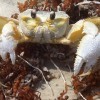Abstract
The new Florida 4-H Aquatic and Marine Ecosystems: Leader’s Activity Guide helps leaders address the 4-H Science Initiative and is part of the Environmental Sciences Framework, OUR NATURAL WORLD. This framework includes the basic premise that aquatic/marine environments are important in children’s lives, particularly to those children in Florida. The 4-H Aquatic and Marine Ecosystems curriculum provides an opportunity for young people to practice a variety of life skills while learning marine science concepts. The curriculum also utilizes science inquiry as a way for young people (9-14) to gain a deeper curiosity about the natural world. Written by Karen Blyler and Joy Jordan, and published by the UF Department of 4-H Youth Development, November 2014.
4H352/4H352: Aquatic and Marine Ecosystems—Appendices: Glossary and Additional Resources (ufl.edu)
References
All About Corals and Coral Reefs. (1993). Sea World, Inc.
Amos, William H. and Stephen H. (1985). The Audubon Society Nature Guides: Atlantic and Gulf Coasts. New York: Alfred A. Knopf.
Coral Reefs: A Gallery Program. National Aquarium in Baltimore.
Meyers and Ewel. (1990). Ecosystems of Florida. Orlando: University of Central Florida Press.
Ranger Rick's NatureScope: Diving Into Oceans. (1992). Washington, D.C.: National Wildlife Federation.
Scouting Guide to The Florida Keys, A. (1986). The Florida National High Adventure Sea Base.

